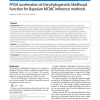SP
2008
IEEE
14 years 2 months ago
2008
IEEE
Abstract. Phylogenetic inference is considered a grand challenge in Bioinformatics due to its immense computational requirements. The increasing popularity and availability of larg...
JCB
2006
14 years 2 months ago
2006
For a model of molecular evolution to be useful for phylogenetic inference, the topology of evolutionary trees must be identifiable. That is, from a joint distribution the model p...
BMCBI
2010
14 years 3 months ago
2010
Background: Likelihood (ML)-based phylogenetic inference has become a popular method for estimating the evolutionary relationships among species based on genomic sequence data. Th...
SC
2000
ACM
14 years 7 months ago
2000
ACM
Recent advances in DNA sequencing technology have created large data sets upon which phylogenetic inference can be performed. However, current research is limited by the prohibiti...
GECCO
2005
Springer
14 years 8 months ago
2005
Springer
Evolutionary relationships among species can be represented by a phylogenetic tree and inferred by optimising some measure of fitness, such as the statistical likelihood of the t...
IPPS
2009
IEEE
14 years 9 months ago
2009
IEEE
Driven by novel biological wet lab techniques such as pyrosequencing there has been an unprecedented molecular data explosion over the last 2-3 years. The growth of biological seq...



